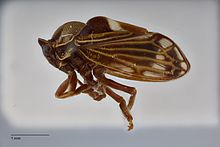| Aetalionidae Temporal range: Oligocene–Recent PreꞒ Ꞓ O S D C P T J K Pg N | |
|---|---|

| |
| Tropidaspis carinata | |
| Scientific classification | |
| Domain: | Eukaryota |
| Kingdom: | Animalia |
| Phylum: | Arthropoda |
| Class: | Insecta |
| Order: | Hemiptera |
| Suborder: | Auchenorrhyncha |
| Superfamily: | Membracoidea |
| Family: | Aetalionidae Spinola, 1850 |
| Subfamilies | |
| |
Aetalionidae are a family of treehoppers in the superfamily Membracoidea. Aetalionidae are somewhat like Membracidae in that they have one to three rows of short spines on the hind tibia but differ in having the front femur fused to the trochanter and the scutellum is completely exposed. The females have finger-like protrusions on the genital capsule. The family is mostly Neotropical. The subfamily Biturritiinae is Neotropical while the subfamily Aetalioninae has a Neotropical genus Aetalion and the sole Old World representative genus Darthula with a single species Darthula hardwickii (which is eaten in parts of China and India).
| |||||||||||||||||||||||||||
| Family relations within the Membracoidea |
They form aggregations on the branches of trees where they produce honeydew and are associated with ants and stingless bees. Aetalionid treehoppers are also known for their maternal care with females standing guard over their eggs.

When disturbed, species like Darthula hardwickii are known to raise their tails in a threatening posture.
References
- Dietrich, C.H. (2009). "Auchenorrhyncha". In Resh, V.H.; Carde, R.T. (eds.). Encyclopedia of Insects. Elsevier. p. 62. ISBN 9780123741448.
- Chen, Xiaoming; Feng, Ying; Chen, Zhiyong (2009). "Common edible insects and their utilization in China". Entomological Research. 39 (5): 299. doi:10.1111/j.1748-5967.2009.00237.x.
- Cryan, Jason R (2005). "Molecular phylogeny of Cicadomorpha (Insecta: Hemiptera: Cicadoidea, Cercopoidea and Membracoidea): Adding evidence to the controversy". Systematic Entomology. 30 (4): 563. doi:10.1111/j.1365-3113.2004.00285.x.
- Almeida-Neto, M.; Izzo, T.J.; Raimundo, R.L.G.; Rossa-Feres, D.C. (2003). "Reciprocal interference between ants and stingless bees attending the honeydew producing Homopteran Aetalion reticulatum (Homoptera: Aetalionidae)" (PDF). Sociobiology. 42 (2): 369–380.
- Dietrich, C.H. (2002). "Evolution of Cicadomorpha (Insecta, Hemiptera)" (PDF). Denisia. 4: 155–169.
- Parva, C.A. (1919). "Rhynchota from the Garo Hills". Records of the Indian Museum. 16: 349–377.
- Deitz, Lewis L; Dietrich, Christopher H (1993). "Superfamily Membracoidea (Homoptera: Auchenorrhyncha). I. Introduction and revised classification with new family-group taxa". Systematic Entomology. 18 (4): 287. doi:10.1111/j.1365-3113.1993.tb00667.x.
External links
| Taxon identifiers | |
|---|---|
| Aetalionidae | |
This Hemiptera article related to members of the insect suborder Auchenorrhyncha is a stub. You can help Misplaced Pages by expanding it. |